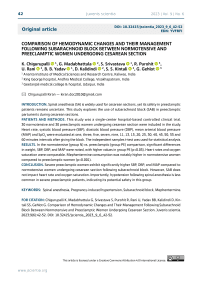Comparison of hemodynamic changes and their management following subarachnoid block between normotensive and preeclamptic women undergoing cesarean section
Автор: Chigurupalli K., Madabhattula G., Srivastava S., Purohit R., Rani U., Yadav B.B., Kalidindi D., Kintali S.S., Gehlot G.
Журнал: Juvenis scientia @jscientia
Рубрика: Оригинальные исследования
Статья в выпуске: 6 т.9, 2023 года.
Бесплатный доступ
Introduction. Spinal anesthesia (SA) is widely used for cesarean sections, yet its safety in preeclamptic patients remains uncertain. This study explores the use of subarachnoid block (SAB) in preeclamptic parturients during cesarean sections. Patients and Methods. This study was a single-center hospital-based controlled clinical trial. 30 normotensive and 30 preeclamptic women undergoing cesarean section were included in the study. Heart rate, systolic blood pressure (SBP), diastolic blood pressure (DBP), mean arterial blood pressure (MAP) and SpO2 were evaluated at one, three, five, seven, nine, 11, 13, 15, 20, 25, 30, 40, 45, 50, 55 and 60 minutes intervals after giving the block. The independent samples t-test was used for statistical analysis.
Spinal anesthesia, pregnancy-induced hypertension, subarachnoid block, mephentermine
Короткий адрес: https://sciup.org/14129342
IDR: 14129342 | DOI: 10.32415/jscientia_2023_9_6_42-52
Список литературы Comparison of hemodynamic changes and their management following subarachnoid block between normotensive and preeclamptic women undergoing cesarean section
- Cook TM, Counsell D, Wildsmith JA, et al. Major complications of central neuraxial block: report on the Third National Audit Project of the Royal College of Anaesthetists. Br J Anaesth. 2009;102(2):179-190. DOI: 10.1093/bja/aen360
- Rodgers A, Walker N, Schug S, et al. Reduction of postoperative mortality and morbidity with epidural or spinal anaesthesia: results from overview of randomised trials. BMJ. 2000;321(7275):1493. DOI: 10.1136/bmj.321.7275.1493
- Mohammed EL, El Shal SM. Efficacy of different size Quincke spinal needles in reduction of incidence of Post-Dural Puncture Headache (PDPH) in Caesarean Section (CS). Randomized controlled study. Egyptian J Anaesth. 2017;33:53-8.
- Pritchard JA, MacDonald PC. Hypertensive disorders in pregnancy. In: Pritchard JA, Macdonald PC, editors. Williams Obstetrics. 15 th ed. New York: Appleton Century Crofts; 1976. p. 551-812.
- Saha D, Ghosh S, Bhattacharyya S, et al. Comparison of hemodynamic response and vasopressor requirement following spinal anaesthesia between normotensive and severe preeclamptic women undergoing caesarean section: A prospective study. J Obstet Anaesth Crit Care. 2013;3:23-26. DOI: 10.4103/2249-4472.114286
- Chaudhary S, Salhotra R. Subarachnoid block for caesarean section in severe preeclampsia. J Anaesthesiol Clin Pharmacol. 2011;27(2):169-173. DOI: 10.4103/0970-9185.81821
- Mitra M, Basu D, Ganguly T, et al. Comparison of the Hemodynamic Alterations in Normotensive and Preeclamptic Pregnant Woman Posted for Cesarean Section under Subarachnoid Block. J Cardiovasc Dis Diagn. 2016;4: 242:1-7.
- Gofton EN, Capewell V, Natale R, Gratton RJ. Obstetrical intervention rates and maternal and neonatal outcomes of women with gestational hypertension. Am J Obstet Gynecol. 2001;185(4):798-803. DOI: 10.1067/mob.2001.117314
- Terrone DA, Isler CM, May WL, et al. Cardiopulmonary morbidity as a complication of severe preeclampsia HELLP syndrome. J Perinatol. 2000;20(2):78-81. DOI: 10.1038/sj.jp.7200315
- Tihtonen K, Kööbi T, Yli-Hankala A, et al. Maternal haemodynamics in pre-eclampsia compared with normal pregnancy during caesarean delivery. BJOG. 2006;113(6):657-663. DOI: 10.1111/j.1471-0528.2006.00931.x
- Kinzhalova SV, Makarov RA, Davydova NS. Hemodynamic effects of spinal anaesthesia during caesarian section in pregnant women with hypertensive disorders. Anesteziol Reanimatol. 2014;(3):25-29.
- Hurley RJ, Lambert DH. Continuous spinal anesthesia with a microcatheter technique: preliminary experience. Anesth Analg. 1990;70(1):97-102. DOI: 10.1213/00000539-199001000-00017
- Hood DD, Curry R. Spinal versus epidural anesthesia for cesarean section in severely preeclamptic patients: a retrospective survey. Anesthesiology. 1999;90(5):1276-1282. DOI: 10.1097/00000542-199905000-00009
- Sharwood-Smith G, Clark V, Watson E. Regional anaesthesia for caesarean section in severe preeclampsia: spinal anaesthesia is the preferred choice. Int J Obstet Anesth. 1999;8(2):85-89. DOI: 10.1016/s0959-289x(99)80003-x
- Hawkins JL, Koonin LM, Palmer SK, Gibbs CP. Anesthesia-related deaths during obstetric delivery in the United States, 1979-1990. Anesthesiology. 1997;86(2):277-284. DOI: 10.1097/00000542-199702000-00002
- Hawkins JL, Chang J, Palmer SK, et al. Anesthesia-related maternal mortality in the United States: 1979-2002. Obstet Gynecol. 2011;117(1):69-74. DOI: 10.1097/AOG.0b013e31820093a9
- Bromage PR. Epidural Analgesia. Philadelphia: WB Saunders; 1978.
- Aya AGM, Mangin R, Vialles N, et al. Patients with severe preeclampsia experience less hypotension during spinal anesthesia for elective cesarean delivery than healthy parturients: a prospective cohort comparison. Anesth Analg. 2003;97(3):867-872. DOI: 10.1213/01.ANE.0000073610.23885.F2
- Dyer RA, Piercy JL, Reed AR, et al. Hemodynamic changes associated with spinal anesthesia for cesarean delivery in severe preeclampsia. Anesthesiology. 2008;108(5):802-811. DOI: 10.1097/01.anes.0000311153.84687.c7
- Aya AGM, Vialles N, Tanoubi I, et al. Spinal anesthesia-induced hypotension: a risk comparison between patients with severe preeclampsia and healthy women undergoing preterm cesarean delivery. Anesth Analg. 2005;101(3):869-875. DOI: 10.1213/01.ANE.0000175229.98493.2B
- Visalyaputra S, Rodanant O, Somboonviboon W, et al. Spinal versus epidural anesthesia for cesarean delivery in severe preeclampsia: a prospective randomized, multicenter study. Anesth Analg. 2005;101(3):862-868. DOI: 10.1213/01.ANE.0000160535.95678.34


